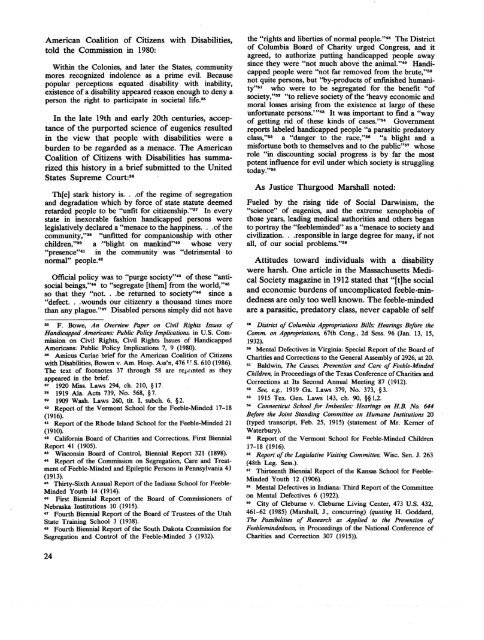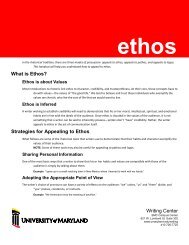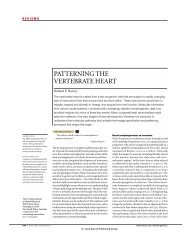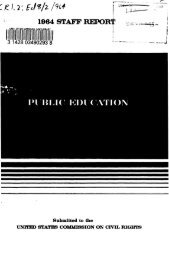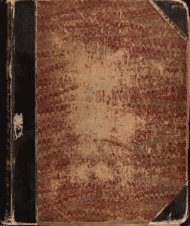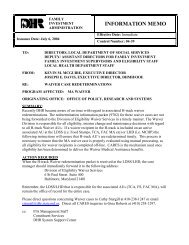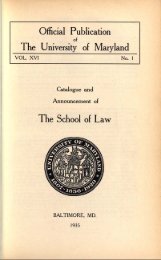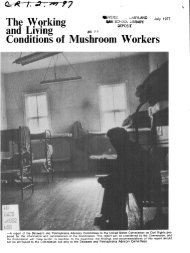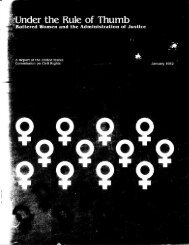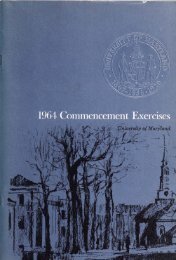American Coalition <strong>of</strong> Citizens with Disabilities,told the Commission in 1980:Within the Colonies, and later the States, communitymores recognized indolence as a prime evil. Becausepopular perceptions equated disability with inability,existence <strong>of</strong> a disability appeared reason enough to deny aperson the right to participate in societal life. 35In the late 19th and early 20th centuries, acceptance<strong>of</strong> the purported science <strong>of</strong> eugenics resultedin the view that people with disabilities were aburden to be regarded as a menace. The AmericanCoalition <strong>of</strong> Citizens with Disabilities has summarizedthis history in a brief submitted to the UnitedStates Supreme Court: 36Th[e] stark history is. . .<strong>of</strong> the regime <strong>of</strong> segregationand degradation which by force <strong>of</strong> state statute deemedretarded people to be "unfit for citizenship." 37 In everystate in inexorable fashion handicapped persons werelegislatively declared a "menace to the happiness. . .<strong>of</strong> thecommunity," 38 "unfitted for companionship with otherchildren," 39 a "blight on mankind" 40 whose very"presence" 41 in the community was "detrimental tonormal" people. 42Official policy was to "purge society" 43 <strong>of</strong> these "antisocialbeings," 44 to "segregate [them] from the world," 45so that they "not. . .be returned to society" 46 since a"defect. . .wounds our citizenry a thousand times morethan any plague." 47 Disabled persons simply did not havessF. Bowe, An Overview Paper on Civil Rights Issues <strong>of</strong>Handicapped Americans: Public Policy Implications, in U.S. Commissionon Civil Rights, Civil Rights Issues <strong>of</strong> HandicappedAmericans: Public Policy Implications 7, 9 (1980).38Amicus Curiae brief for the American Coalition <strong>of</strong> Citizenswith Disabilities, Bowen v. Am. Hosp. Ass'n, 476 U.S. 610 (1986).The text <strong>of</strong> footnotes 37 through 58 are reprinted as theyappeared in the brief.371920 Miss. <strong>Law</strong>s 294, ch. 210, §17.381919 Ala. Acts 739, No. 568, §7.391909 Wash. <strong>Law</strong>s 260, tit. I, subch. 6, §2.40Report <strong>of</strong> the Vermont <strong>School</strong> for the Feeble-Minded 17-18(1916).41Report <strong>of</strong> the Rhode Island <strong>School</strong> for the Feeble-Minded 21(1910).42California Board <strong>of</strong> Charities and Corrections, First BiennialReport 41 (1905).43Wisconsin Board <strong>of</strong> Control, Biennial Report 321 (1898).44Report <strong>of</strong> the Commission on Segregation, Care and Treatment<strong>of</strong> Feeble-Minded and Epileptic Persons in Pennsylvania 43Minded Youth 14 (1914).46First Biennial Report <strong>of</strong> the Board <strong>of</strong> Commissioners <strong>of</strong>Nebraska Institutions 10 (1915).47Fourth Biennial Report <strong>of</strong> the Board <strong>of</strong> Trustees <strong>of</strong> the UtahState Training <strong>School</strong> 3 (1938).48Fourth Biennial Report <strong>of</strong> the South Dakota Commission forSegregation and Control <strong>of</strong> the Feeble-Minded 3 (1932).(1913).45Thirty-Sixth Annual Report <strong>of</strong> the Indiana <strong>School</strong> for Feeble-the "rights and liberties <strong>of</strong> normal people." 48 The District<strong>of</strong> Columbia Board <strong>of</strong> Charity urged Congress, and itagreed, to authorize putting handicapped people awaysince they were "not much above the animal." 49 Handicappedpeople were "not far removed from the brute," 50not quite persons, but "by-products <strong>of</strong> unfinished humanity"51 who were to be segregated for the benefit "<strong>of</strong>society," 52 "to relieve society <strong>of</strong> the 'heavy economic andmoral losses arising from the existence at large <strong>of</strong> theseunfortunate persons.' " 53 It was important to find a "way<strong>of</strong> getting rid <strong>of</strong> these kinds <strong>of</strong> cases." 54 Governmentreports labeled handicapped people "a parasitic predatoryclass," 55 a "danger to the race," 56 "a blight and amisfortune both to themselves and to the public" 57 whoserole "in discounting social progress is by far the mostpotent influence for evil under which society is strugglingtoday." 58As Justice Thurgood Marshall noted:Fueled by the rising tide <strong>of</strong> Social Darwinism, the"science" <strong>of</strong> eugenics, and the extreme xenophobia <strong>of</strong>those years, leading medical authorities and others beganto portray the "feebleminded" as a "menace to society andcivilization. . .responsible in large degree for many, if notall, <strong>of</strong> our social problems." 59Attitudes toward individuals with a disabilitywere harsh. One article in the Massachusetts MedicalSociety magazine in 1912 stated that "[t]he socialand economic burdens <strong>of</strong> uncomplicated feeble-mindednessare only too well known. The feeble-mindedare a parasitic, predatory class, never capable <strong>of</strong> self49District <strong>of</strong> Columbia Appropriations Bills: Hearings Before theComm. on Appropriations, 67th Cong., 2d Sess. 96 (Jan. 13, 15,1932).50Mental Defectives in Virginia: Special Report <strong>of</strong> the Board <strong>of</strong>Charities and Corrections to the General Assembly <strong>of</strong> 2926, at 20.51Baldwin, The Causes, Prevention and Care <strong>of</strong> Feeble-MindedChildren, in Proceedings <strong>of</strong> the Texas Conference <strong>of</strong> Charities andCorrections at Its Second Annual Meeting 87 (1912).s2See, e.g., 1919 Ga. <strong>Law</strong>s 379, No. 373, §3.531915 Tex. Gen. <strong>Law</strong>s 143, ch. 90, §§1,2.54Connecticut <strong>School</strong> for Imbeciles: Hearings on H.B. No. 644Before the Joint Standing Committee on Humane Institutions 20(typed transcript, Feb. 25, 1915) (statement <strong>of</strong> Mr. Kerner <strong>of</strong>Waterbury).55Report <strong>of</strong> the Vermont <strong>School</strong> for Feeble-Minded Children17-18 (1916).56Report <strong>of</strong> the Legislative Visiting Committee, Wise. Sen. J. 263(48th Leg. Sess.).57Thirteenth Biennial Report <strong>of</strong> the Kansas <strong>School</strong> for Feeble-Minded Youth 12 (1906).58Mental Defectives in Indiana: Third Report <strong>of</strong> the Committeeon Mental Defectives 6 (1922).59City <strong>of</strong> Cleburne v. Cleburne Living Center, 473 U.S. 432,461-62 (1985) (Marshall, J., concurring) (quoting H. Goddard,The Possibilities <strong>of</strong> Research as Applied to the Prevention <strong>of</strong>Feeblemindedness, in Proceedings <strong>of</strong> the National Conference <strong>of</strong>Charities and Correction 307 (1915)).24
support or <strong>of</strong> managing their own affairs." 60 AChicago ordinance provided that no person "who isdiseased, maimed, mutilated or in any way deformedso as to be an unsightly or disgusting object orimproper person" could be found "in or on thepublic ways or other public places," and that nosuch person could "expose himself to public view." 61In Heredity and Human Progress, a physicianadvocated that children with severe disabilities,including "idiots," most "imbeciles," and "epileptics"should be eliminated for the safety <strong>of</strong> theNation through the use <strong>of</strong> a painless gas. 62In 1941 a physician addressing a luncheon duringthe annual meeting <strong>of</strong> the American PsychiatricAssociation said: "[W]e have too many feeblemindedpeople among us. . . .The idiot and the imbecileseem to me unresponsive to the care put upon them.They are not capable <strong>of</strong> being educated; nor cansuch defective products ever be made to be so." 63He spoke "in favor <strong>of</strong> euthanasia for those hopelessones who should never have been born—Nature'smistakes," urging that when a "competent medicalboard. . .acting. . .on the application <strong>of</strong> the guardians<strong>of</strong> the child, and after three examinations <strong>of</strong> adefective who has reached the age <strong>of</strong> five or more,should decide that that defective has no future norhope <strong>of</strong> one. . .it is a merciful and kindly thing torelieve that defective—<strong>of</strong>ten tortured and convulsed,grotesque and absurd, useless and foolish,and entirely undesirable—<strong>of</strong> the agony <strong>of</strong> living." 64An editorial in the issue <strong>of</strong> the American Journal <strong>of</strong>Psychiatry that published the physician's addresssuggested that the attitude <strong>of</strong> parents who opposedelimination <strong>of</strong> their "idiot" children was a fit subjectfor psychiatric analysis and correction:It is difficult to conceive how normal affection can be feltfor a creature incapable <strong>of</strong> the slightest response; andexaggerated sentimentality or forced devotion which canserve no possible purpose can hardly be looked upon asdesirable. . . .[T]he psychiatric problem. . .[<strong>of</strong>] the "fondness" <strong>of</strong> theparents <strong>of</strong> an idiot and their "want" that he should be kept60A.M. Clark and A.D.B. Clarke, eds., Mental Deficiency: TheChanging Outlook, 16-17, quoted in Evans, The Lives <strong>of</strong>Mentally Retarded People 43 (1983).« Formerly Chicago, 111., Mun. Cod. §36-34 (1966).« D. McKim, Heredity and Human Progress 189, 193 (1900).83Kennedy, The Problem <strong>of</strong> Social Control <strong>of</strong> the CongenitalDefective, 49 Am. J. Psychiatry 13, 13 (1942).alive. . .we believe deserves study—the extent to which itexists, in fact and not merely as a generalization <strong>of</strong> opinion,what underlying factors. . .are discoverable, whether itcan be assessed as healthy or morbid, and whether in thelatter case it is modifiable by exposure to mental hygieneprinciples. 65Although contemporary justifications for denial<strong>of</strong> treatment to children with disabilities are typicallyless harshly worded, a clear continuity <strong>of</strong> thoughtcan <strong>of</strong>ten be found. Contemporary bioethicist PeterSinger writes:When the death <strong>of</strong> a defective infant will lead to the birth<strong>of</strong> another infant with better prospects <strong>of</strong> a happy life, thetotal amount <strong>of</strong> happiness will be greater if the defectiveinfant is killed. The loss <strong>of</strong> happy life for the first infant isoutweighed by the gain <strong>of</strong> a happier life for the second. 86A noted authority on child abuse and neglect arguesthat the state should intervene to save the life <strong>of</strong> achild only when the child would have a "life worthliving or a life <strong>of</strong> relatively normal healthygrowth." 67The complex and difficult questions surroundingtreatment decisionmaking for children with disabilitiesmust be approached with sensitivity to theeffects <strong>of</strong> this background <strong>of</strong> dehumanizing attitudesconcerning people with disabilities. Dehumanizingstereotypes are common to virtually every form <strong>of</strong>discrimination, including that based on disability. 68This report thus begins with an examination <strong>of</strong> thecontext <strong>of</strong> such decisionmaking in a chapter thatexplores the parent-physician relationship and thesort <strong>of</strong> information about disability sometimes providedparents by physicians. The next chaptersconsider what the evidence suggests about thepotential quality <strong>of</strong> life <strong>of</strong> people with disabilities incontrast to what are <strong>of</strong>ten inaccurate assumptionsabout their quality <strong>of</strong> life. The report then describesin detail the history and current status <strong>of</strong> legalstandards governing medical treatment for thosewith disabilities. The degree to which these standardsare being implemented and the performance <strong>of</strong>governmental and nongovernmental institutions inenforcing them are assessed. The report ends withfindings <strong>of</strong> fact and recommendations for the future.84Id. at 14.85Euthanasia, 99 Am. J. Psychiatry 141, 143 (1942).86Peter Singer, Practical Ethics 134 (1979).67J. Goldstein, Medical Care for the Child at Risk: On StateSupervention <strong>of</strong> Parental Autonomy, 86 Yale L.J. 645, 651 (1977).68See generally U.S. Commission on Civil Rights, Accommodatingthe Spectrum <strong>of</strong> Individual Abilities 22 (1983).25
- Page 1 and 2: MedicalDiscriminationAgainstChildre
- Page 3 and 4: idments • Section 504 • Medical
- Page 5: LETTER OF TRANSMITTALThe PresidentT
- Page 9 and 10: CONTENTSExecutive Summary 11. Funda
- Page 11: 12. The Performance of the Federal
- Page 14 and 15: • The role of economic considerat
- Page 16 and 17: disabilities at the time that the c
- Page 19 and 20: generated by health care personnel
- Page 21: ing how they would obtain medical r
- Page 24 and 25: The Commission sees several advanta
- Page 26 and 27: acquiescence in the death or elimin
- Page 28 and 29: Services of the Department of Healt
- Page 30 and 31: Chapter 1Fundamental Rights: An Int
- Page 32 and 33: Carlton Johnson was evaluated by a
- Page 34 and 35: "that Mr. and Mrs. Doe, after havin
- Page 38 and 39: Chapter 2The Physician-Parent Relat
- Page 40 and 41: In all but a few cases, the parents
- Page 42 and 43: the family, and the family went alo
- Page 44 and 45: Chapter 3The Role of Quality of Lif
- Page 47: transition from education to employ
- Page 50 and 51: tion programs can become productive
- Page 52 and 53: unsuccessful efforts of a private a
- Page 54 and 55: [S]ince I have been at Children's M
- Page 56 and 57: Another survey by Siperstein, Wolra
- Page 58 and 59: of life with a child who is disable
- Page 60 and 61: Chapter 4The Role of Economic Consi
- Page 62 and 63: ©TABLE 4.1Pediatricians' Responses
- Page 64 and 65: • The differences in average cost
- Page 66 and 67: FIGURE 4.1Comparative Costs of Inst
- Page 68 and 69: Chapter 5State LawWhat is the law g
- Page 70 and 71: Like all authority. . .parental aut
- Page 72 and 73: This decision, however, was promptl
- Page 74 and 75: No otherwise qualified handicapped
- Page 76 and 77: Bloomington's Infant Doe in April 1
- Page 78 and 79: ONONTABLE 6.1Physician's assessment
- Page 80 and 81: Essentially, HHS interpreted the su
- Page 82 and 83: Final 504 RuleHHS received nearly 1
- Page 84 and 85: lifesaving operations to close her
- Page 86 and 87:
any further implementation of the F
- Page 88 and 89:
handicapped infants might violate S
- Page 90 and 91:
the provision does cover discrimina
- Page 92 and 93:
of the infants. The review mechanis
- Page 94 and 95:
Under the law, the Department of He
- Page 96 and 97:
that "the phrase 'or holds the reas
- Page 98 and 99:
allows an infant to be denied nutri
- Page 100 and 101:
avoid the explicit standards set fo
- Page 102 and 103:
(as opposed to the far) future, the
- Page 104 and 105:
It was recognized, therefore, that
- Page 106 and 107:
als with the particular disability
- Page 108 and 109:
cared for. They are thus different,
- Page 110 and 111:
medical advice. Given the magnitude
- Page 112 and 113:
tions at all regarding the subject
- Page 114 and 115:
strates that there is a grave dange
- Page 116 and 117:
Disincentives to Whistle BlowingDen
- Page 118 and 119:
Using a cumulative scaling procedur
- Page 120 and 121:
Of that 300 we targeted, approximat
- Page 122 and 123:
Conclusionphysicians set forth in t
- Page 124 and 125:
taking place when a report of suspe
- Page 126 and 127:
where the parents say "the child fe
- Page 128 and 129:
Nevertheless, the organization oppo
- Page 130 and 131:
Chapter 11The Role and Performance
- Page 132 and 133:
a member of the American Academy of
- Page 134 and 135:
possibilities that "will be most li
- Page 136 and 137:
clearly indicate that the committee
- Page 138 and 139:
Reviewing the first 30 months of th
- Page 140 and 141:
Webster's defines "suspected" as "t
- Page 142 and 143:
Chapter 12The Performance of the Fe
- Page 144 and 145:
The baby's doctor, E. Laurence Hode
- Page 146 and 147:
to achieve a reasonable life". . .w
- Page 148 and 149:
an unmarried mother receiving welfa
- Page 150 and 151:
can be sure all appropriate actions
- Page 152 and 153:
inquiries to determine whether they
- Page 154 and 155:
Chapter 13The Protection and Advoca
- Page 156 and 157:
authority to conduct retrospective
- Page 158 and 159:
facility that uses such a committee
- Page 160 and 161:
Chapter 14Findings and Recommendati
- Page 162 and 163:
as the coordination and development
- Page 164 and 165:
in the advisory process who is conc
- Page 166 and 167:
A Dissenting View on the Report Med
- Page 168 and 169:
arts) to depend upon knowledge of h
- Page 170 and 171:
Attachments to Statement of William
- Page 172 and 173:
medical facility. Considerations su
- Page 174 and 175:
Fund for the Improvement of Postsec
- Page 176 and 177:
eports such as Kopelman et al. demo
- Page 178 and 179:
Appendix 1EXPOSING OUR CHILDREN, EX
- Page 180 and 181:
abilities or functions, they are de
- Page 182 and 183:
My principal reason for objecting t
- Page 184 and 185:
I derive this hint from the many co
- Page 186 and 187:
moral distinction. A girl is a huma
- Page 188 and 189:
Appendix 2SURVEY OFSTATE BABY DOE P
- Page 190 and 191:
insure the immediate referral of po
- Page 192 and 193:
Hospital Liaisons Designated in Mos
- Page 194 and 195:
BABY DOE COMPARED WITH REGULAR CPS
- Page 196 and 197:
We also asked state CPS offices wha
- Page 198 and 199:
Limited information was available o
- Page 200 and 201:
one-quarter felt that baby doe case
- Page 202 and 203:
Appendix 3INFANT CARE REVIEW COMMIT
- Page 204 and 205:
and guidelines concerning the withh
- Page 206 and 207:
treated to assure the prompt ^repor
- Page 208 and 209:
3. Educating Staff and FamiliesThre
- Page 210 and 211:
One of the 10 ethics committees vis
- Page 212 and 213:
asphyxiation during the birth proce
- Page 214 and 215:
Prospective Review -- Each committe
- Page 216 and 217:
OBSERVATIONSThe inspection found th
- Page 218 and 219:
May 1, 1989Page 2The Commission adv
- Page 220 and 221:
Doe 1 admitted on the record of the
- Page 222 and 223:
tion is the basis for failure to tr
- Page 224:
her (much appreciated) vote for thi


